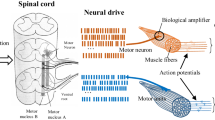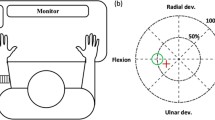Abstract
Myoelectric hand-prostheses are used by patients with either above- or below-elbow amputations and actuated with a minimal microvolt-threshold myoelectric signal (MES). Prehensile motions or patterns are deduced from the MES by classification. Current approaches act on the assumption, that MES is adiabatic-invariant and unaffected by fatigue of contributory muscles. However, classifiers fail on the onset of muscle fatigue and cannot distinguish between voluntary-, submaximal-contraction and an intentional release of muscle tension. As a result, patients experience a gradual loss of control over their prostheses. In this contribution we show, that the probability distributions of extracted time- and frequency-domain features are fatigue dependent with regard to locality, skewness and time. Also, we examine over which time-frame, established classifiers provide unambiguous results and how classifiers can be improved by the selection of a proper sampling-window size and an appropriate threshold for select features.
Access this chapter
Tax calculation will be finalised at checkout
Purchases are for personal use only
Preview
Unable to display preview. Download preview PDF.
Similar content being viewed by others
References
Oskoei, M.A., Hu, H.: Myoelectric Control Systems - A Survey. Biomedical Signal Processing and Control 2(4), 275–294 (2007)
Englehart, K., Hudgins, B., Parker, P., Stevenson, M.: Classification of the Myoelectric Signal using Time-Frequency Based Representations. Special Issue of Medical Engineering and Physics on Intelligent Data Analysis in Electromyography and Electroneurography 21, 431–438 (1999)
Muzumdar, A.: Powered Upper Limb Prostheses, Control, Implementation and Clinical Application. Springer, Heidelberg (2004)
MacIsaac, D., Parker, P., Englehart, K., Rogers, D.: Fatigue Estimation with a Multivariable Myoelectric Mapping Function. IEEE Transactions on Biomedical Engineering 53(4), 694–700 (2006)
De Luca, C.J.: The Use of Surface Electromyography in Biomechanics. Journal of Aplied Biomechanics 13, 135–163 (1997)
De Luca, C.J.: Myoelectric Manifestations of Localized Muscular Fatigue in Humans. Crit Rev Biomedeical Engineering 11(4), 251–279 (1984)
Bischoff, C., Schulte-Mattler, W.J., Conrad, B.: Das EMG-Buch; EMG und periphere Neurologie in Frage und Antwort. Georg Thieme Verlag (2005)
Merletti, R., Farina, D.: Myoelectric Manifestations of Muscle Fatigue. In: Wiley Encyclopedia of Biomedical Engineering. John Wiley & Sons, Inc., Chichester (2006)
Merlo, A., Farina, D., Merletti, R.: A Fast and Reliable Technique for Muscle Activity Detection from Surface EMG Signals. IEEE Transactions on Biomedical Engineering 50(3), 316–323 (2003)
Oskoei, M.A., Hu, H., Gan, J.Q.: Manifestation of Fatigue in Myoelectric Signals of Dynamic Contractions Produced During Playing PC Games. In: Proc. 30th Annual International Conference of the IEEE Engineering in Medicine and Biology Society EMBS 2008, pp. 315–318 (2008)
Bonato, P., Roy, S.H., Knaflitz, M., De Luca, C.J.: Time-Frequency Parameters of the Surface Myoelectric Signal for Assessing Muscle Fatigue During Cyclic Dynamic Contractions. IEEE Transactions on Biomedical Engineering 48(7), 745–753 (2001)
Radicheva, N., Gerilovsky, L., Gydikow, A.: Changes in the Muscle Fibre Extracellular Action Potentials in Long-Lasting (Fatiguing) Activity. European Journal of Applied Physiology and Occupational Physiology 55, 545–552 (1986)
Buchenrieder, K.: Dimensionality Reduction and Classification of Myoelectric Signals for the Control of Upper-Limb Prostheses. In: Proceedings of the IASTED - Human Computer Interaction 2008, pp. 113–119 (2008)
Author information
Authors and Affiliations
Editor information
Editors and Affiliations
Rights and permissions
Copyright information
© 2009 Springer-Verlag Berlin Heidelberg
About this paper
Cite this paper
Herrmann, S., Buchenrieder, K.J. (2009). Dynamic Behavior of Time-Domain Features for Prosthesis Control. In: Moreno-Díaz, R., Pichler, F., Quesada-Arencibia, A. (eds) Computer Aided Systems Theory - EUROCAST 2009. EUROCAST 2009. Lecture Notes in Computer Science, vol 5717. Springer, Berlin, Heidelberg. https://doi.org/10.1007/978-3-642-04772-5_72
Download citation
DOI: https://doi.org/10.1007/978-3-642-04772-5_72
Publisher Name: Springer, Berlin, Heidelberg
Print ISBN: 978-3-642-04771-8
Online ISBN: 978-3-642-04772-5
eBook Packages: Computer ScienceComputer Science (R0)




